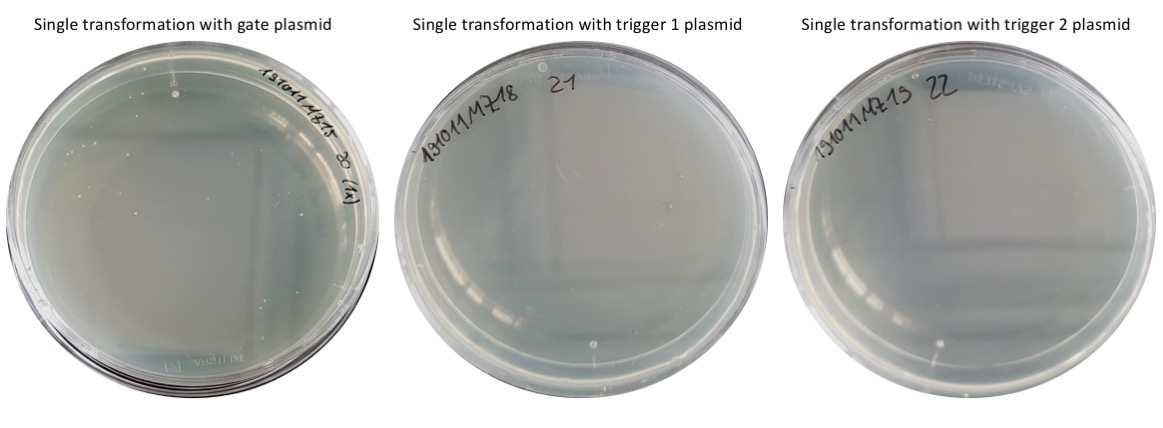Part:BBa_K2970003
Trigger 1 Composition
Trigger 1 forms together with Trigger 2 (BBa_K2970001) a complex due to complementary regions, as shown in Figure 1A. This complex can open a gate (BBa_K2970002, Figure 1B) to enable translation of a gene that is locked with this gate to regulate translation. After binding of the trigger complex due to complementarity, the hairpin of the gate will open and release the ribosome binding site and the start codon, thus translation can occur (Figure 2). The affinity between the trigger complex and the gate is greater than that of the gate to itself (in the loop). A single trigger cannot open the gate because it has only half the required complementary sequence.


Usage and Biology
This part can be used together with the other trigger composition and the gate composition for triple transformation in bacteria. Genes of interest that should be transformed together, can be put on the three plasmids. Only if all three plasmids are taken by a bacterium the chloramphenicol resistance is produced and the bacterium can survive on medium with chloramphenicol. Thus chloramphenicol can be used to select for bacteria that got all genes of interest.
Results
We tested the gate plasmid with our two trigger plasmids by performing simultaneous transformations with these plasmids. After transformation we selected the bacteria by plating on LB-agar plates with chloramphenicol. We compared the results with positive and negative controls, using the empty pSB1C3 backbone and pSB1A3 respectively.
The result of the transformation with all three plasmids after selection with chloramphenicol is shown in Figure 3.

Colonies grew on chloramphenicol plates after transformation with all three plasmids. This shows that our RNA based logic circuit allows the expression of the antibiotic resistance. No colonies grew on the plates with the negative control. Colonies also grew on the plates with the positive control.
To further test the trigger and the gate, we performed transformations with each plasmid individually. The results are shown in Figure 4.

Unfortunately colonies also grew on the plates with just the individual transformation of the gate plasmid, though the number of colonies was much lower when compared to the transformation with all three plasmids. We sequenced the gate plasmid to confirm correct assembly. The results showed no mutation in the gate sequence. We concluded that the gate is showing signs of leakage, expressing the antibiotic resistance even in the absence of triggers. This basal expression was rather strong due to the strong promoter we used for our experiments.
To measure the gates leakage, we observed cells transformed with all three plasmids on plates with different chloramphenicol concentrations and compared them to cells transformed with only the gate plasmid. As a positive control we used the pSB1C3 backbone. The number of colonies per plate after twelve hours of incubation is shown in Figure 5.

The data clearly shows that the gate is leaking, but when compared to the triple transformation (red) and the control (green) the number of colonies when transformed with only the gate plasmid was significantly lower. Additionally the number of colonies when transformed with all three plasmids was larger than when transformed with the positive control.
We also used a plate reader to measure the growth rate of cells that were transformed with three different plasmids (pSB1A3, pSB1C3, pSB1K3 or BBa_K2970003, BBa_K2970004, BBa_K2970006) and compared it to cells without any plasmids. The results are shown in Figure 6.

For cells transformed with three plasmids an impaired growth rate can be observed. We could not show that the transformation of our three plasmids was less harmful to the bacteria than the transformation with three different antibiotics, instead it shows comparable levels of stress.
Due to the linker between the gate and our gene of interest (chloramphenicol acetyl transferase) additional bases were attached to the gene which might affect the functionality of the protein as it contained an additional 19 amino acids. To test the genes activity we inserted the sequence containing the additional bases into pSB1A3, transformed it into bacteria and plated the cells on chloramphenicol plates. The results of this experiment are shown in Figure 7.

Several colonies grew on the plate with bacteria transformed with the modified chloramphenicol acetyl transferase. The negative control showed no cell growth while on the plate with the positive control a cell turf has grown. This confirms that the activity of the chloramphenicol acetyl transferase was not significantly impaired by the additional amino acids.
Sequence and Features
- 10COMPATIBLE WITH RFC[10]
- 12INCOMPATIBLE WITH RFC[12]Illegal NheI site found at 7
Illegal NheI site found at 30 - 21COMPATIBLE WITH RFC[21]
- 23COMPATIBLE WITH RFC[23]
- 25COMPATIBLE WITH RFC[25]
- 1000COMPATIBLE WITH RFC[1000]
| None |
